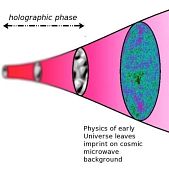
Is the Universe a hologram? The Greek researcher behind the findings explains
The universe could turn out to be a “vast and complex hologram”, meaning that life in 3D is an illusion, astrophysicists have said. Researchers from the University of Southampton, working with colleagues from Canada and Italy, say they have found substantial evidence of a holographic universe – an idea first suggested in the 1990s. The research was led by a Greek scientist.
Professor Kostas Skenderis is Director of STAG within Mathematical Sciences at the University of Southampton.
The researchers reached their conclusion after investigating irregularities in the cosmic microwave background – otherwise known as the “afterglow” of the Big Bang. Evidence for the theory matches more traditional explanations in strength, they have said. Thus, what we think of as our 3D world may be an illusion.
Professor of mathematical sciences at Southampton, Kostas Skenderis, said it was similar to watching a 3D film in the cinema. While we perceive the pictures as having height, width and depth, they do in fact come from a flat screen.
“What is the structure of space and time? Has time a beginning or the Universe has always existed? These are some of the questions that concerned humans since ancient times. In the first moments of the Universe, the entire Universe was “compressed” into such a small space that only a quantum theory of gravity could describe it. Theoretical research in quantum gravity in the last 20 years has given evidence that the Universe is holographic, meaning that at a fundamental level the Universe is two-dimensional (plus the time) and the extra dimension (and gravity) is the result of the dynamic theory. The purpose of my recent work has been to look for observational evidence of holography in the primordial cosmic radiation. This radiation comes from the first moments of the Universe and its structure contains information about the laws of nature in the primordial Universe. We found that all the observations can be explained by a holographic model and that the observational data is equally compatible with both the new holographic model and the standard model of cosmology” Professor Skenderis said at ellines.com
The scientists now hope their study will open the door to further our understanding of the early universe and explain how space and time emerged.
“Our goal now is to create a holographic model describing the whole history of the Universe, and not only its first moments. The holography is a radical idea for the structure of space and time and only time will tell where it will lead us” he added.













Παναγιώτης Τουμάσης
-12/02/2017 3:01 pm
Είναι το ίδιο επαναστατική αυτή η θεωρία, όπως ήταν και ο Ιδεαλισμός όταν πρωτοεμφανίστηκε ως φιλοσοφικό ρεύμα.
Thierry Poget
-03/08/2019 6:25 pm
Cher Professeur Skenderis,
Bonjour,
Je viens de lire un article sur le site eveilhomme.com, concernant votre théorie d’univers holographique et je trouve que cela rejoins les paroles du Bouddha Sakyamouni lorsqu’il enseignait que tout n’était qu’illusion.
Je me permets de vous écrire, car bien que n’étant “que” de la métaphysique, je viens d’écrire un manuscrit “Nouvelle voie pour l’éveil” qui sera publié cet automne par la maison d’Editions parisienne Spinelle et dont certaines parties pourraient vous intéresser.
Malheureusement je ne parle et ne comprends que le français, mais si cela vous intéresse écrivez-moi et je me ferai un plaisir de vous faire parvenir ce manuscrit sous format PDF à l’adresse qui vous conviendra.
Bien entendu et sous réserve que ce manuscrit est conditionné aux droits de l’éditeur et aux droits d’auteur, vous ne pourrez pas le diffuser, ni le céder, par contre, si vous le trouvez intéressant, je souhaiterais bien trouver une personne qui serait susceptible de pouvoir le traduire en anglais, afin de pouvoir le faire publier et le diffuser dans cet langue.
Dans l’intervalle à votre réponse, je vous prie de recevoir, Cher Professeur Skenderis, mes sincères autant que respectueuses salutations.
Thierry Poget